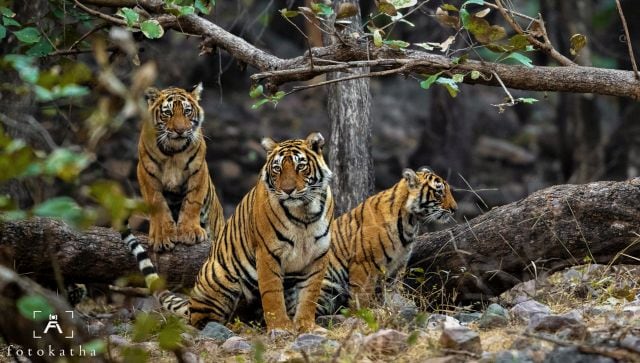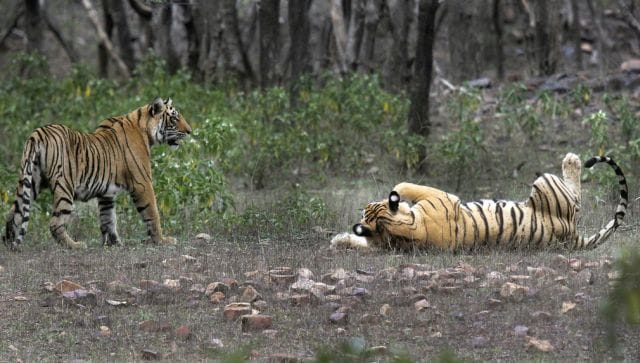How will we accommodate the big cats?

The forests of India are reverberating with the roar of the Royal Bengal Tiger. Once on the brink of extinction, the striped cat is now thriving. There are 3,167 tigers in the wild in the country, as per the fifth cycle of India’s Tiger Census released by Prime Minister Narendra Modi. The 2018 Tiger Census released in July 2019 said that there were 2,967 tigers in the country. That’s a rise of 200 in the past four years.
The conservation efforts have paid off and India has every reason to be proud. It’s now home to 70 per cent of the world’s wild tiger population, which stands at around 4,500, according to the World Wildlife Fund. The numbers are expected to go up steadily and with the rising population comes growing challenges.
The data does not tell the complete story – of man-animal conflict and territorial wars. Do India’s tiger reserves have enough space to accommodate the apex predator? And what if we face a problem of plenty?
As India celebrates 50 years of Project Tiger, we take a look at what the future holds for the big cats.
Saving the tiger
A century ago, there were an estimated more than 100,000 wild tigers across Asia. They were hunted as trophies and for parts of their body – nails, fur, whiskers, tails and bone. Their numbers started plummeting and the destruction of habitat as the human population boomed made matters worse.
Until the end of the 19th Century, India still had 40,000 tigers but rampant killing brought the numbers to a mere 1,411 in 1972. It was now or never if India needed to save its tigers. That’s when then-Prime Minister Indira Gandhi stepped in. Tiger hunting was officially banned and the Wildlife Protection Act came into force in 1972.
A year on, Project Tiger was launched by the Centre on 1 April 1973 to conserve the beautiful big cat. In the same year, the International Union for Conservation of Nature declared the tiger an endangered species.
Launched at Uttarakhand’s Jim Corbett National Park, the programme dedicated to preserving the animal was started in nine tiger reserves in Assam, Bihar, Karnataka, Madhya Pradesh, Maharashtra, Odisha, Rajasthan, Uttar Pradesh and West Bengal, covering over 14,000 sq km. Now it covers 53 such protected areas, spanning 75,800 sq km.
From 1,411 tigers in 1972 to 3,167 in 2022, Project Tiger has been a conservation success story that has caught the world’s attention. But as the number of tigers grows, so does India’s human population.
Back in 1971, the country had 547 million people. Today, India is home to 1.4 billion and is set to overtake China as the world’s most populous country. So what does that mean for tiger conservation?
A problem of plenty?
Over the years, tiger habitats have been encroached upon. Several villages have been relocated to make space for the animal. But it’s not enough.
Every reserve has a core zone and a buffer zone. While core zones have no human intervention, the buffers are the adjoining areas where nature is preserved alongside compatible human use of resources such as land and water. Often, villagers living on the periphery of the reserves graze their cattle in the buffer areas.
There has been a steady increase in population in the core areas. Tigers are solitary and territorial creatures. As their population increases and territories overlap, there’s more conflict between the cats. Invariably, a dominant male drives out the weaker one. Where does the defeated one go? In search of new territory, sometimes to the buffer zones or stray into human landscapes.

But now even the buffer zones are seeing an explosion in the tiger population. There were 80 tigers in the buffer zones of six tiger reserves in Madhya Pradesh. In Maharashtra’s Tadoba-Andhari Tiger Reserve, there is no dearth of tigers in the buffer areas. Karnataka’s Bandipur and Nagarahole parks are in desperate need of increasing the buffer areas.
In 2019, Rajesh Gopal, former head of Project Tiger and the chief of Global Tiger Fund, the inter-governmental international body set up for the conservation of big cats in the wild, said that India’s tiger capacity is packed and the forests cannot hold any more tigers. How true is that?
Also read: Maya, Machli, Munna, naam toh suna hoga?: How India’s legendary tigers got their names
Man vs tiger
With more and more tigers in buffer zones, the chances of human-animal conflict increase. If cattle stray into tiger territory, it makes for easy prey and this often leaves the villagers angry and bitter. Though the forest department is quick to compensate for the loss of livestock, it’s not a full-proof solution.
Villagers poison the dead cattle and tigers who come back to eat their hunt fall prey to it. Three years ago, an adult tigress and her two cubs died after they drank from a water body which was poisoned in the Moharli range of Tadoba’s buffer. A similar case of revenge was reported from Goa’s Mhadei Wildlife Sanctuary, where a tigress and three cubs were killed.
In October 2022, a three-year-old male tiger, blamed for the death of nine people, was gunned down after a shoot-at-sight order at Valmiki Tiger Reserve in Bihar’s West Champaran region.
Assam’s Orang National Park has a small core area of 79 sq km and is struggling to cope with its rising big cat population. Incidents of tigers moving in and out of surrounding human habitation has become an everyday affair.
“Attending to human-animal conflict takes almost 70% of our time and resources as a result of which other equally important conservation works get affected,” said Ramesh Kumar, Director, Bandipur Tiger Reserve told The Hindu last July, adding that tigers are being increasingly sighted on the forest periphery and have to be captured or pushed back.

According to SP Yadav, head of Project Tiger and member secretary of the National Tiger Conservation Authority (NTCA), there are several tiger reserves where the tiger population has reached their carrying capacity like Corbett, Madhya Pradesh’s Kanha, Pench, Bandhavgarh, Panna, Tadoba Andhari, and Rajasthan’s Ranthambhore. In Sundarbans too, the population is pushing the reserve’s carrying capacity. But there is a way forward.
“At the same time, there are other tiger reserves which are low density and have the potential to accommodate more tigers. We need to actively manage our tiger population,” Yadav added.
Also read: Explained: Why is India planning to send tigers to Cambodia?
Managing the tiger population
Managing tiger reserves is based on a scientific plan and every tiger reserve in the country has a long-term tiger strategy chalked out.
There’s plenty of empty tiger habitat in India – currently around 300,000 sq km of which only 90,000 is occupied by tigers, according to a report by India Today.
So, yes translocating some of the tigers within the country is a possibility. But it’s important to ensure that these locations have enough prey from the cats. Weaning tribal communities off bush meat and controlling militancy in these regions is also essential, the report points out.
“There is scope to add another 1,000-1,500 tigers primarily in the forested habitats of Chhattisgarh, Jharkhand, Odisha, and North Eastern States of Arunachal, Nagaland, Mizoram, and Assam,” YV Jhala, eminent conservationist and former dean of the Wildlife Institute of India, told IndiaToday.in.
Maintaining tiger habitats
Saving the tiger is as much about saving its habitat. Unlike the leopard, the tiger is not too happy moving out of its territory but the increasing numbers are forcing it to do so. Hence conservationists including the Wildlife Insitute of India have emphasised the need to secure Critical Tiger Habitats. Tiger corridors that allow animals to move from one reserve to another are the key.
Jhala calls these corridors “umbilical cords for the survival of tiger reserve populations”, India Today reports.

“Maintaining Critical Tiger Habitats, as also tiger corridors connecting various forests where it can move freely and avoid inbreeding, would place a tiger as a part of the holistic system, and not above it. In its essence, the approach entails supporting “all life” and not just the tiger,” writes senior journalist Ajay Suri in ThePrint.
While habitats and corridors can and need to be created over time, it is not a one-stop solution.
A lot then depends on the people who share space with these predators. Beyond the generous compensation, the benefit of having enchanting wildlife in the neighbourhood is something that needs to be driven home. Tigers and the tourists they bring are a big source of revenue and if shared with locals, they’d not look at the tiger as the problem but as a resource.
As Indira Gandhi said 50 years ago: “The tiger cannot be preserved in isolation.”
With inputs from agencies
Read all the Latest News, Trending News, Cricket News, Bollywood News,
India News and Entertainment News here. Follow us on Facebook, Twitter and Instagram.

Atul Tiwari is a seasoned journalist at Mumbai Times, specializing in city news, culture, and human-interest stories. With a knack for uncovering compelling narratives, Atul brings Mumbai’s vibrant spirit to life through his writing.





